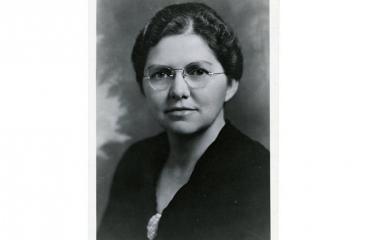In 1918, the University Student Health Service was founded to “protect the health of students and prevent disease.” Ruth Boynton served as the director from 1936 to 1961. She was the first woman in the country to direct a co-educational health service.
Boynton was a devoted physician and academician; a professor dedicated to teaching and research, and widely respected by all who knew her; she also made roughly twice what most of her male colleagues did in the 1940s.
As we move into 2020, the designated moniker for the start of the new decade is of 20/20 vision. In line with this acumen, it is helpful to reflect on the contributions from past visionaries.
A LESSON FROM HISTORY
Born in 1896, Ruth Boynton would grow up to become an influential doctor and public health advocate. Boynton’s mother passed away in her youth. She would witness the final illnesses of her two brothers and the infinite care and attendance from their family physician, which inspired her to study medicine.
In 1921, Boynton received her medical degree from the University of Minnesota, graduating at the top of her class. In her first year as a physician, she treated students during an outbreak of scarlet fever and influenza.
After being appointed director for the University’s Student Health Service in 1936, Boynton helped build one of the most comprehensive health services in the country. She created an interprofessional team around her, including a dietician, a public health engineer, and a health educator. Her competency and diplomacy as an administrator were legendary.
Tuberculosis was the most prevalent disease on campus at the time. In 1939, Boynton discovered that the rate of infection was greater among student nurses than in other schools. She was deeply invested in the diagnosis and treatment of the disease for much of her career. She studied tuberculosis among children from 1915 to 1932. She also reported on the health of the Chippewa population in Minnesota and attributed the high incidence of tuberculosis resulting from crowded and unhygienic living conditions.
J. Arthur Myers described his colleague Boynton “as having done a pioneer work in the control of tuberculosis among students.”
By 1957, Boynton and co-authors Myers and Howard Diehl reported: “The accomplishments of the tuberculosis control program on this campus have been phenomenal. Students no longer die from tuberculosis, and morbidity has been reduced to a trickle.”
Boynton also did a great deal of work on dysmenorrhea, more commonly known as menstrual cramps. She also was a strong advocate for widespread immunizations for preventative health. When it came to illness or injury, Boynton focused on clinical components of care and training. Her passion for preventative medicine and public health manifested in her lifelong commitment to student health.
During World War II, she completed medical examinations for soldiers. She also acted as head of the original School of Public Health while its dean, Gaylord W. Anderson, MD, DrPH, served during the war.
When an epidemic of influenza broke out in 1943, Boynton worked long hours to ensure everyone received care. The high demand of students needing medical attention led to Boynton overseeing the planning for a new health service building. She prioritized environmental sanitation and made sure surveys were done for new or renovated spaces, and that food handlers went through training programs and medical examinations. The new health service building was completed in 1950 opposite the out-patient entrance to the University hospitals.
While Boynton received countless awards and accolades in her lifetime, more importantly she made sure to leave behind pathways for others to pursue medicine. She created the Prudence Catright Scholarship for an outstanding woman graduate student in health education. She contributed resources to the student health service to establish a learning resources center for staff, and a scholarship to be awarded annually in the name of Ruth E. Boynton to a woman medical student with financial need.
After retiring from the University in 1961, Boynton moved to Florida where she volunteered her time as the secretary-treasurer of the American College Health Association for several years.
In 1975, the University of Minnesota honored her career and contributions by renaming the Student Health Service to Boynton Health Service, the name it still bears today.
Boynton’s early colleague and friend William P. Shepard described her as having, “integrity, steadfastness of purpose, loyalty, good humor, empathy, and uncanny wisdom. Ruth Boynton will long be remembered among school health professionals.” Boynton passed away in 1977.
“Reimagine Health” is a series covering remarkable individuals making a difference in health and health care. Through novel approaches and interprofessional collaboration, the Office of Academic Clinical Affairs is reimagining health for Minnesota and beyond. Together we can address complex problems affecting community and individual health.



